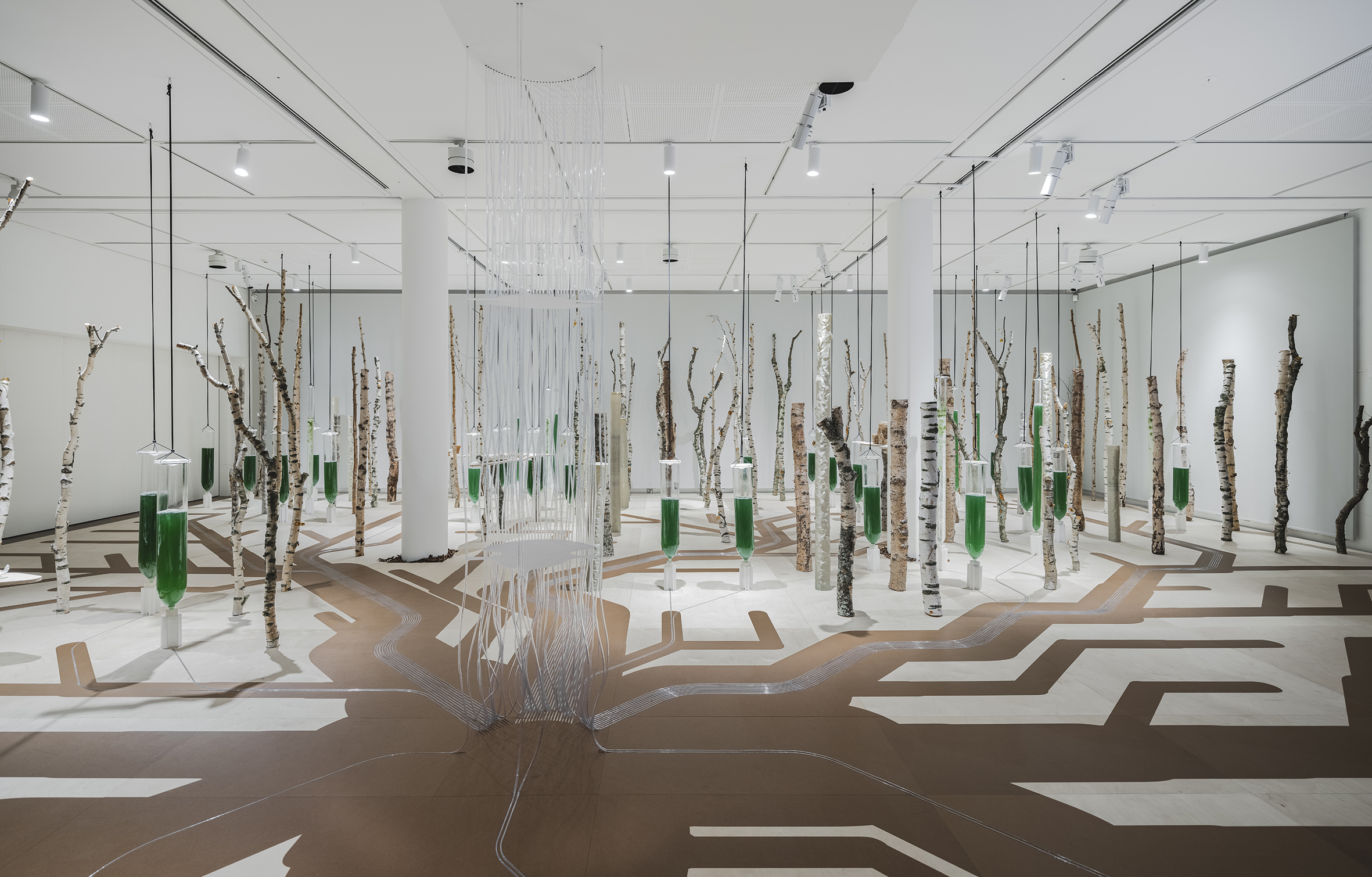Deep.Forest is an immersive exhibition environment based on regional satellite data translated into a deconstructed woodland landscape
Commissioned by the Louisiana Museum of Modern Art in Denmark in 2023, Deep.Forest celebrates the naturalisation of architecture and technology, in itself a reversal on the modernist project to mechanise nature. The exhibition “Living Structures” is part of “Architecture Connecting”, a new series of shows curated by Mette Marie Kallehauge, spotlighting the evolution of architecture in an era of climate crisis and the social, cultural and political challenges this reality poses.

“Diving deeply into a forest means losing oneself into the multiplicity of interconnecting processes that define its very existence; and with it our own identity. In our contemporary world these processes are biological and digital, as both us and the forest are cyber-organic networks. Like the slime mould greeting visitors at the entrance of the Deep Forest exhibition, it serves as both a woodland fungus and a biological computer—a form of wetware AI infrastructure with the capacity to plan a city.”
— affirms Claudia Pasquero, ecoLogicStudio co-founder; UIBK and UCL Professor of biodigital architecture.
Deep.Forest gives architectural form to the micromanagement of photosynthesis and biodegradation as a circular process. It transforms one of the rooms of the Louisiana Museum into a biodigital interior space. Upon entering, visitors are immersed in a deconstructed woodland landscape, isolating the three essential processes of a forest in the form of three different types of Deep.Trees: Photosynthesizers, biodegraders and carbon storers.
Arranged in a regular grid pattern, their spatial arrangement mirrors the vegetation density of the regional forests surrounding the Louisiana Museum, captured by the machine eyes of the Copernicus and Sentinel 2 satellites. Processed by an algorithm mimiking the hidden Wood Wide Web of mycelium in a forest, this satellite imagery dictates the planar organisation of the projects on show, arranging the aeration system of the photosynthetic reactors and guiding the visitors along suggested paths.





Deep Forest hosts five thematic areas that showcase a variety of projects undertaken in recent years by ecoLogicStudio and its academic partners. Highlights include GAN-Physarum: La dérive numérique, a machine learning algorithm trained to mimic the behaviour of living slime mould, envisioning a bio-digital, autonomous Paris; Tree One, a living sculpture previously exhibited in Korea and China; and the results of research led by Prof. Claudia Pasquero’s students in the Synthetic Landscape Lab at Innsbruck University. The exhibition also features ecoLogicStudio’s recent book, DeepGreen: Biodesign in the Age of Artificial Intelligence, and the bio-digital gardening project H.O.R.T.U.S. XL Astaxanthin.g.


While there are no limits to mycelium’s applications in biodesign, Deep.Forest focuses on its symbiosis with photosynthetic microalgae. The forest’s circularity relies on photosynthesis, not only from tree leaves but also from algae, which form a symbiotic bond with mycelium, creating lichens that sustain this interconnected ecosystem.


102 carbon storers made of salvaged birch trunks host a variety of lychen species within the exhibition space and provide context for the photosynthesizers, the 44 glass vessels hosting living cultures of cyanobacteria and seaweeds that supply the museum’s room with fresh oxygen and carbon sequestration.
The 44 photosynthesizers are designed and engineered by ecoLogicStudio and capture 600g of CO2/day from the atmosphere, the equivalent of a small mature forest. Among these, 15 taller units contain macroalgae species typical of the local shores, while 29 shorter units house microalgae varieties of Spirulina SP.



The Spirulina microlagae also provide biomass to 3D print 20 biodegraders at the Synthetic Landscape Lab at the University of Innsbruck. They are 3D printed with algae infused biopolymer, containing coffee ground serving as substrate for colonies of living mycelium. They feed on the sugars in the coffee grounds, and grow to form a new space filling network, a solid synthetic trunk. The proprietary bio-fabrication process involves burying the synthetic mycelium trunks in the ground for up to 3 weeks to allow mycelium to fully develop its networks and reach the designed material and aesthetic consistency. At this stage the trunks can be extracted and dried to acquire mechanical resistance and beauty. Occasionally some areas can be kept wet to allow fruiting bodies to grow, with fresh mushrooms popping out from gaps in the 3D printed bark.


creating Deep.Tree typologies
In synthesis, Deep Forest gives architectural form to the micromanagement of photosynthesis as a circular process. It embodies the dream of growing sustainable architecture from the waste and pollution emitted in the contemporary Urbansphere.

“Photosynthesis is fire in reverse. There is too much fire in the world, so to counteract fire we need more photosynthesis and we need to design it, to customise it.”
— Mario Carpo during his interview with Claudia Pasquero and Marco Poletto recorded for the exhibition catalogue.
